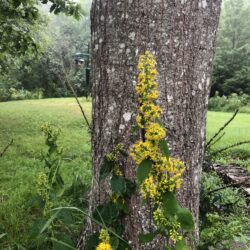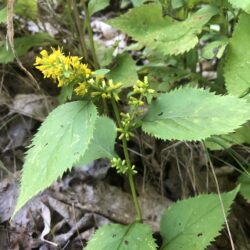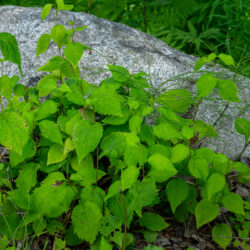Etymology
Solidago is from Latin meaning to make whole, an allusion to reputed healing qualities; flexicaulis is from Latin meaning having a flexible stem.
Native Habitat
Woodlands and thickets.
Garden Uses
This is an interesting goldenrod with attractive foliage for a shady woodland garden. If not deadheaded, it will seed around and fill in empty areas.
Overview
This is a perennial woodland species that does best in sun-dappled part shade, but will also grow in full shade. It grows in clumps in average, well-drained soil. It may self-seed in the garden and spread by rhizomes.
Leaves and Stems
The leaves are 2 -7” long, broad-ovate, alternately arranged and have toothed margins and sharply pointed tips. The leaves become smaller as they rise on the stem. The sometimes zigzag erect stems give this goldenrod one of its common names. Stems sometimes have tiny hairs.
Flowers
The central stalks are terminated by narrow panicles or racemes of golden flower heads. Smaller flower clusters occur lower on the stems originating in the leaf axils. Each flowerhead is ¼” across with 3-4 ray florets and 4-8 disc-shaped florets.
Fruit/Seed
In autumn the florets mature into bullet shaped achenes crowned by tufts of hair. The achenes are distributed by wind and offsets form from the underground rhizomes.
Animal Associates
Native bees, wasps, butterflies, and pollinating flies seek nectar and pollen from the flowers, as do honeybees. Plants host caterpillars of several moth species. Seeds are eaten by songbirds and upland game birds. White-tailed deer graze on the foliage.
Propagation
May be grown from seed and rhizomes. Seeds disperse over time from fall into winter.
Ethnobotanical Uses
Goldenrod is believed to possess diuretic, anti-inflammatory, antioxidant and astringent properties and has long been used to relieve urinary tract disorders.
Garden Location
Performance Hall Garden (see garden map)
Anecdotal Information
The name goldenrod refers to the flowering plant’s appearance as a golden scepter.
Sources
Plant Profile by Kathy Kling



